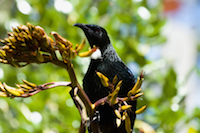 I missed getting his photo by 10 seconds, 15 at the most.
I missed getting his photo by 10 seconds, 15 at the most.
And then I spent the rest of that Saturday peering out the window, into trees, watching empty patches of sky, listening intently. I could hear him quite regularly, as I had done for the past couple of months, but I’ve only seen him that once, and that was for just five seconds when I stepped out the back door to put some rubbish in the bin.
There he was, perched boldly and very obvious up in the bare, skinny-rib branches of the neighbour’s liquidambar, now leafless after the storm that lashed most of the country in mid-June. He was plainly a tui – dark, sheening, gunmetal-blue plumage, solidly-built, the merest twist of a white bow-tie, and resplendent in that sharp-eyed, bow-beaked haughtiness for which tui are well-known. They sort of glare at the world with the same ice-eyed stare used by aged spinster school-teachers who have ruled, mercilessly, classes of eight-year-old boys for the past half-century.
This guy – and I take a liberty to presume the bird is a he and not a female (though the glare and the above comparison makes me double-think on that) – this guy has been loitering around the southern suburbs of Te Awamutu for the past several months. I’m beginning to think he may even have been hatched in the area, rather than be a daily visitor from the native bush on Kakepuku or Pirongia or perhaps Maungatautari. Probably his parents were all part of the halo programme sparked a decade or so ago by some intelligent, broadminded and far-sighted people who understood that if you want the native birds, or any birdlife, back in town, you’ve got to invite them in.
So they planted trees and flowers and gardens that wafted out scents and pheromones and other luscious enticements to the birdlife beyond the urban boundaries. Here in Te Awamutu, and in many other Waikato towns now too, there are kowhai, and flax, and flowering gum and cherries and a host of other trees and garden flowers I don’t know about, all of them resplendent in beautiful, succulent, nectar-bearing blossoms that tui love. Other birds dabble in such sweet-meats too, especially the bellbird, yet to be heard commonly throughout the region, but numbers are growing.
Birds in general benefit from such plantings – there are lots of good places for nesting, trees invariably harbour large numbers of insects that are a rich food source for both adults and nestlings, they provide a wide range of fruits and edible shoots, and they are good, safe places to spend the night hours. Of special delight to me is that massive trees such as the oaks and poplars and totara provide those wonderful high minaret aeries for the song birds – the blackbirds and the thrushes – to soar out their daily matins and evensong for those who are out of doors in the half-light of dawn or the chill of a darkening dusk.
But my little tui friend has been struggling. It seems to be a problem for young tui – they all appear to have a major difficulty getting a handle on the melodious business of being a grown-up bird. Many years ago I woke in a tent set up in a camping ground near Nelson, and, being a dairy farmer’s son it was just dawn. The sound that woke me was the call of a bird I’d never heard before, yet I’d spent some reasonable time out in the bush hunting and tramping and generally enjoying the magnificence of mountains and wilderness. The sound was sort of strangled and gargled and – dare I say it – constipated, as though the bird had a lot more to say but simply couldn’t get it out.
So I slid out of my Arctic sleeping bag, snigged on an oversized Swanni bush-shirt that well-covered my butt, and slipped into my boots. I also had with me a pair of 7 x 50 binoculars, top gear in those days. Fifty metres from the tent was a small stand of fully deciduous trees, maybe silver birch, and high in the branches of one of them was this young tui. It was obviously a tui, just like the one we’ve got here, with brilliant plumage and bulky build, but he couldn’t sing like a tui to save himself.
Neither can this bloke in Te Awamutu.
But I have to give him credit. Several months ago he first started “chucking” in the neighbourhood, I’m presuming as the late hatchling of a pair of tui who may have decided to nest somewhere in the Te Awamutu suburbs rather than back at Kakepuku or Pirongia. The kid has grown up in suburbia – how good is that? If it’s true, it means those smart people have really enticed tui back into the towns because there is food and interesting things for these beautiful birds here in among the long-run roofs and the TV aerials and the close-cut lawns and the flap-about clotheslines. And maybe the tui are not flying in as day-visitors, but instead are overnighting or even staying for the summer nesting season, and in the process producing youngsters who will grow up happy to be townies.
I was telling a learned friend about this the other day, and he assures me that over the past few years tui have begun nesting in and close to Hamilton and several other Waikato towns, and that has to be great news.
This little tui appears to be one of those recolonisers. At this stage he’s not Placido Domingo in a feather cloak. In fact he’s got a way to go, but he’s been trying for a good while. And as I’ve been listening, slowly but surely his vocabulary and repertoire have been expanding. Just recently there’s been the hint of a trill, and a ‘quonk’ or two, almost like a bilious duck, and on several occasions he’s been able to string several of the sounds together.
I really hope he’s successful, because next month tui begin the business of making friends with other tui, and making nests, and making merry. There’s some marvellous trees around this suburb, ideal locations for tui and other birds to set up home.
Even now, on a rather cold and foggy morning, I fancy I can hear him chortling over the prospects of such happy events in the near future. Yep – I stepped out on the terrace, and sure enough, from over the road in among a small patched of mixed native and exotic mature trees came a little shred of melody that is unmistakably tui.
And then, unbelievably, as I am sitting here writing this column and watching out across that little patch of bush, a tui came loping out of the trees in a series of swooping, flickering flights, swung right across my front window and swept up into the top leafless twigs of a neighbouring silver birch. The scrabble for the camera was frantic, but I succeeded in firing off several pictures.
He sat there for perhaps a minute, chuckling and warbling and imperiously glaring about, and I must say his song has improved considerably in the past few days. Maybe it’s the stirrings of early testosterone. Well, if it is, good for him.
But after weeks of watching and listening, how lucky is that to see and hear him so clearly? I hope he sticks around.
Kingsley Field has published two illustrated volumes of his columns and is working on a third. He can be contacted at kingsley(at)accuwrite.co.nz









Join the Discussion
Type out your comment here:
You must be logged in to post a comment.